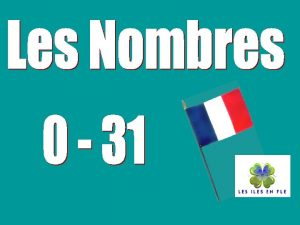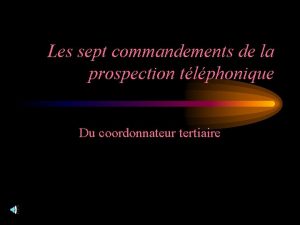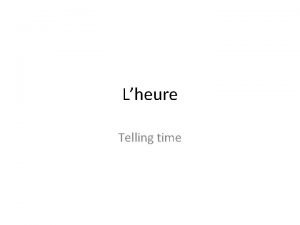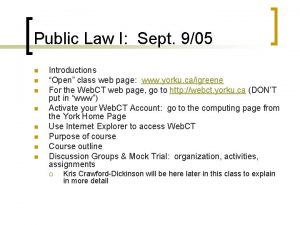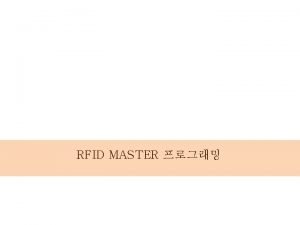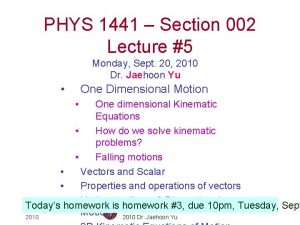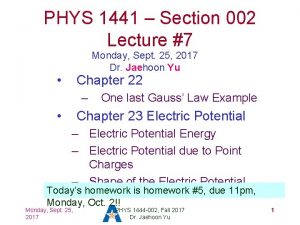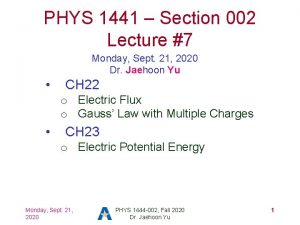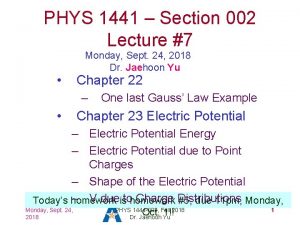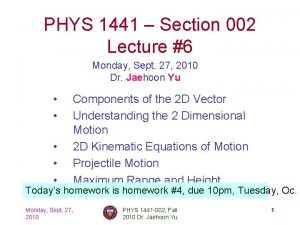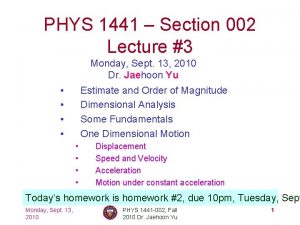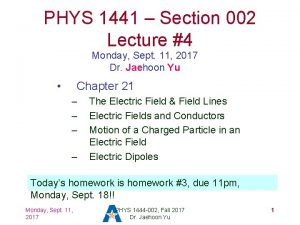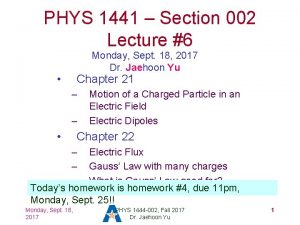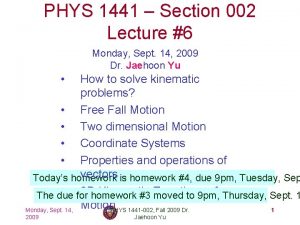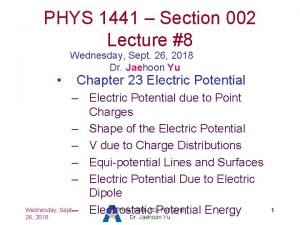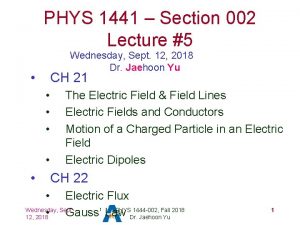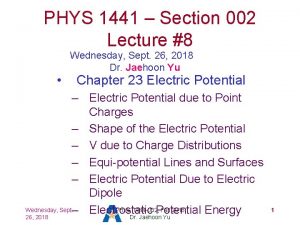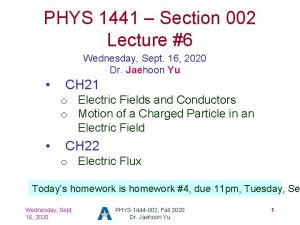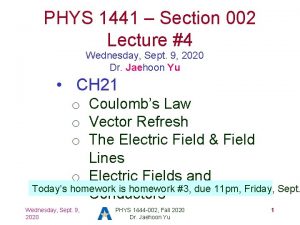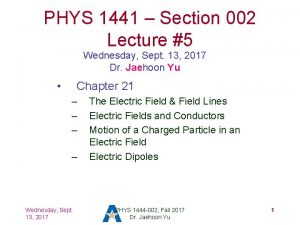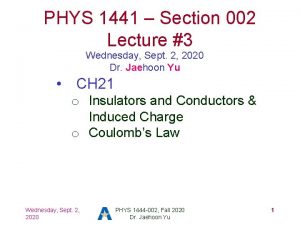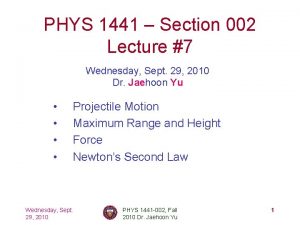PHYS 1441 Section 002 Lecture 5 Monday Sept





















- Slides: 21

PHYS 1441 – Section 002 Lecture #5 Monday, Sept. 14, 2020 Dr. Jaehoon Yu • CH 21 o Vector component refresh o The Electric Field o The Directions of The Electric Field and the Electric Force o Electric Fields and Conductors o Motion of a Charged Particle in an Electric Field Monday, Sept. 14, 2020 PHYS 1444 -002, Fall 2020 Dr. Jaehoon Yu 1

Announcements • 1 st term exam in class Wed. , Sept. 23 – DO NOT MISS THE EXAM! You will get an F! – Come to class by 12: 40 pm, roll call will start at that time – CH 21. 1 to what we’ve learned on next Monday, Sept. 21 + Appendices A 1 – A 9, the math refresher – BYOF: You may bring a one 8. 5 x 11. 5 sheet (front and back) of handwritten formulae and values of constants for the exam – No derivations, word definitions, figures, pictures, setups or solutions of any problems! – No additional formulae or values of constants will be provided! – Must send me the photos of both front & back of the formula sheet, including the blank, in a single file by Monday, Sept. 14, PHYS 1444 -002, Fall 2020 2 11: 00 am, Sept. 23 2020 Dr. Jaehoon Yu

Reminder: SP#2 – Angels & • Compute the total. Demons possible energy released from an annihilation of x-grams of anti-matter and the same quantity of matter, where x is the last two digits of your SS# or DL#. (20 points) – Use the famous Einstein’s formula for mass-energy equivalence • Compute the power output of this annihilation when the energy is released in x ns, where x is again the first two digits of your SS# or DL#. (10 points) • Compute how many cups of gasoline (8 MJ) this energy corresponds to. (5 points) • Compute how many months of world electricity usage (3. 6 GJ/mo) this energy corresponds to. (5 points) • Due by the beginning of the class, 1 pm, Wednesday, Sept. 23 Monday, Sept. 14, 2020 – Must be PHYS 1444 -002, Fall 2020 HANDWRITTEN Dr. Jaehoon Yu 3

• Reminder: SP#3 – Civic Duty I: Voter registration in. Registration Texas ends on Monday, Oct. 5, 2020 – Registration can be done: https: //www. votetexas. gov/register/index. html – Check your registration: https: //teamrvmvp. sos. texas. gov/MVP/mvp. do • For those who are legal to take part in the election – Your own registration to vote: 10 points • Include the screen shot your own voter registration check – You can have up to 3 more people who are not registered to register: 5 points each • Must include before and after the registration screen shots of the same person next to each other to show these are newly registered • For those who are not legal to take part in the election – You can have up to 5 people who are not registered to register: 5 points each • Must include before and after the registration screen shots of the same person next to each other to show these are newly registered Monday, Sept. 14, PHYS 1444 -002, Fall 2020 • Deadline: 1 pm Wednesday, Oct. 2020 Dr. Jaehoon Yu 7, 2020 4

SP#3 – Civic Duty I: Voter Registration – 2 Monday, Sept. 14, 2020 PHYS 1444 -002, Fall 2020 Dr. Jaehoon Yu 5

Components and Unit Vectors Coordinate systems are useful in expressing vectors in their components y (+, +) Fy (Fx, Fy) F Component (-, +) } θ (-, -) Monday, Sept. 14, 2020 (+, -) Fx x PHYS 1444 -002, Fall 2020 Dr. Jaehoon Yu } Magnitud 6

Unit Vectors • A unit vector is the vector that indicates only the directions of the components • Dimensionless • Magnitudes are exactly 1 • Unit vectors are usually expressed in i, j, k or ( preferred method in this class!) So the vector F can be re-written as Monday, Sept. 14, 2020 PHYS 1444 -002, Fall 2020 Dr. Jaehoon Yu 7

Examples of Vector Operations. F 1 i+2. 0 j)N and F 2 Find the resultant force which is the sum of F 1=(2. 0 i-4. 0 j)N. Find the resultant force of the sum of three forces: F 1=(15 i+30 j +12 k)N, F 2=(23 i+14 j -5. 0 k)N, and F 3=(13 i+15 j)N. Magnitu de Monday, Sept. 14, 2020 PHYS 1444 -002, Fall 2020 Dr. Jaehoon Yu 8

Coulomb Force, The Formula Unit charge Monday, Sept. 14, 2020 PHYS 1444 -002, Fall 2020 Dr. Jaehoon Yu 9

How to solve electric F problems? Typical problem: Find out the net force on a subject charge at the given position by some source charges 1. Compute the magnitude of the force by each source charge on the subject charge at the given position using Coulomb force formula 2. Compute the components of the force by the pair of the charges, taking into account the signs of the two charges – subject and source 3. Repeat 1 and 2 for all pairs of each of the source charges to the subject charge 4. Add all values on each component – x, y and z, etc 5. Express F vector using the component and the unit Monday, Sept. 14, PHYS 1444 -002, Fall 2020 10 vector 2020 Dr. Jaehoon Yu

Example 21. 2 • Three charges on a line. Three charged particles are arranged in a line as shown in the figure. Calculate the net electrostatic force on particle 3 (the -4μC on. What theisright) duethat to other twooncharges. the force Q exerts Q? 1 3 What is the force that Q 2 exerts on Q 3? Using the vector sum of the two forces Monday, Sept. 14, 2020 PHYS 1444 -002, Fall 2020 Dr. Jaehoon Yu 11

The Electric Field • Both gravitational and electric forces act over distance without contacting objects What kind of forces are these? – Field forces • Michael Faraday developed the idea of the field. – Faraday (1791 – 1867) argued that the electric field extends outward/inward from every charge and permeates through all of space • Field by a charge or a group of charges can be inspected by placing a small positive test charge in the vicinity and Monday, Sept. 14, PHYS 1444 -002, Fall 2020 measuring the force on it. 2020 Dr. Jaehoon Yu 12

What are the directions of the field? E + + + E - Direction of the field depends only on the sign of the source charge Monday, Sept. 14, 2020 E + PHYS 1444 -002, Fall 2020 Dr. Jaehoon Yu 13

The Electric Field • The electric field at any point in space is defined as the force exerted on a tiny positive test charge divide by magnitude of the test charge – Electric force per unit charge • What kind of quantity is the electric field? (poll 2) – Vector quantity. Why? • What is the unit of the electric field? (poll 3) – N/C • What is the magnitude of the electric field at a distance r from a single point charge Q (source)? Monday, Sept. 14, 2020 PHYS 1444 -002, Fall 2020 Dr. Jaehoon Yu 14

Example 21 – 5 • Electrostatic copier. An electrostatic copier works by selectively arranging positive charges (in a pattern to be copied) on the surface of a non-conducting drum, then gently sprinkling negatively charged dry toner (ink) onto the drum. The toner particles temporarily stick to the pattern on the drum and are later transferred to paper and “melted” to produce the copy. Suppose each toner particle has a mass of 9. 0 x 10 -16 kg and carries the average of 20 extra electrons to provide an electric charge. Assuming that the electric force on a toner particle must exceed twice its weight in order to ensure sufficient attraction, compute the The electric forcefield must be the near samethe assurface twice the force on the ton required electric strength of gravitational the drum. So we can write Thus, the magnitude of the electric field is Monday, Sept. 14, 2020 PHYS 1444 -002, Fall 2020 Dr. Jaehoon Yu 15

Direction of the Electric Field • If there are more than one charge present, the individual fields due to each charge are added vectorially to obtain the total field at any point. • This superposition principle of electric field has been verified by experiments. • For a given electric field E at a given point in space, we can calculate the force F on any charge q, F=q. E. – What happens to the direction of the force and the field depending on the sign of the charge q? – The F and E are in the same directions if q > 0 – The F and E are in the opposite directions if q < 0 Monday, Sept. 14, 2020 PHYS 1444 -002, Fall 2020 Dr. Jaehoon Yu 16

What are the directions of the field vs F? + + E F F E Direction of the field depends only on the sign of the source charg Direction of the force depends on both the signs of the source and subje Monday, Sept. 14, 2020 PHYS 1444 -002, Fall 2020 Dr. Jaehoon Yu 17

How to solve electric F and E problems? Typical problem: Find out the field by some charges at the given position and the net force on a charge at the position by these charges. 1. Compute the magnitude of the field by each charge at the position 2. Compute the components of the field by the charge, taking into account the sign of the charge 3. Repeat 1 and 2 for all charges that affects the field at the position 4. Add all values on each component – x, y and z, etc 5. Express E field vector using the component and the unit vector 6. The net electric force on a subject charge q at the position is then simply using the formula , taking into account Monday, Sept. 1444 -002, Fallthe 2020 direction 18 the sign of 14, the subject. PHYS charge for 2020 Dr. Jaehoon Yu

Example 21 – 8 • E above two point charges: Calculate the total electric field (a) at point A and (b) at point B in the figure on the right due to both the charges Q 1 and Q 2. How do we solve this problem? First, compute the magnitude of fields at each point due to each of the two charges. Then add them at each point vectorially! First, the electric field at point A by Q 1 and then Q 2. Monday, Sept. 14, 2020 PHYS 1444 -002, Fall 2020 Dr. Jaehoon Yu 19

Example 21 – 8, cnt’d Now the components of the electric field vectors by the two charges at point A. So the electric field at point A is The magnitude of the electric field at point A is Now onto the electric field at point B Monday, Sept. 14, 2020 PHYS 1444 -002, Fall 2020 Dr. Jaehoon Yu 20

Example 21 – 8, cnt’d Electric field at point B is easier due to symmetry! Since the magnitude of the charges are the same and the distance to point B from the two charges are the same, the magnitude of the electric field by the two charges at point B are the same!! Now the components! Now, the xcomponent! So the electric field at point B The is magnitude of the electric field at Sept. 14, point. Monday, B 2020 First, the ycomponent! PHYS 1444 -002, Fall 2020 Dr. Jaehoon Yu 21
 Jan van eyck (1390-1441)
Jan van eyck (1390-1441) Physics 241
Physics 241 01:640:244 lecture notes - lecture 15: plat, idah, farad
01:640:244 lecture notes - lecture 15: plat, idah, farad Une deux trois quatre cinq
Une deux trois quatre cinq La guerre de sept ans
La guerre de sept ans Candide ou l optimisme
Candide ou l optimisme Jerusalem seven hills
Jerusalem seven hills Poème la cigale et la fourmi
Poème la cigale et la fourmi Ecrivez les sept jours de la semaine
Ecrivez les sept jours de la semaine Sept commandements
Sept commandements Cnn 10 2018
Cnn 10 2018 Sept heure moins le quart
Sept heure moins le quart Damon poole
Damon poole Sept prefix words
Sept prefix words Sept
Sept I sept
I sept Sept comme setteur questionnaire
Sept comme setteur questionnaire C++ mfc 예제
C++ mfc 예제 Norsok z-018
Norsok z-018 Semt.002
Semt.002 Puneeth iyengar
Puneeth iyengar Cip 002-009
Cip 002-009



